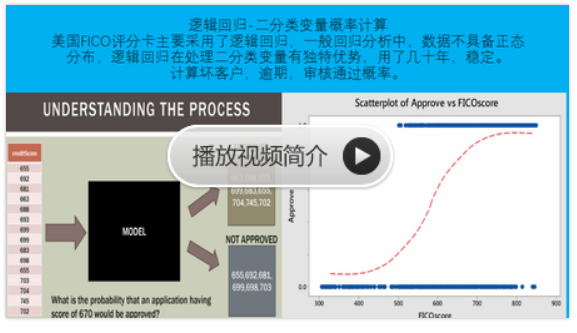sklearn机器学习-泰坦尼克号
sklearn实战-乳腺癌细胞数据挖掘(博主亲自录制视频)
https://study.163.com/course/introduction.htm?courseId=1005269003&utm_campaign=commission&utm_source=cp-400000000398149&utm_medium=share
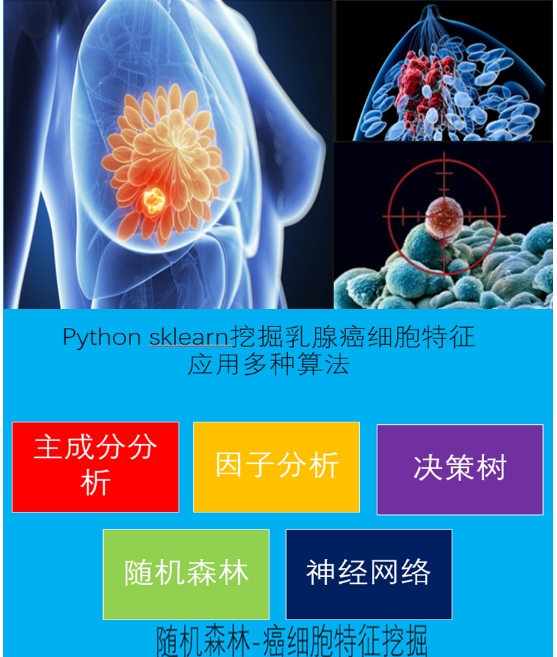
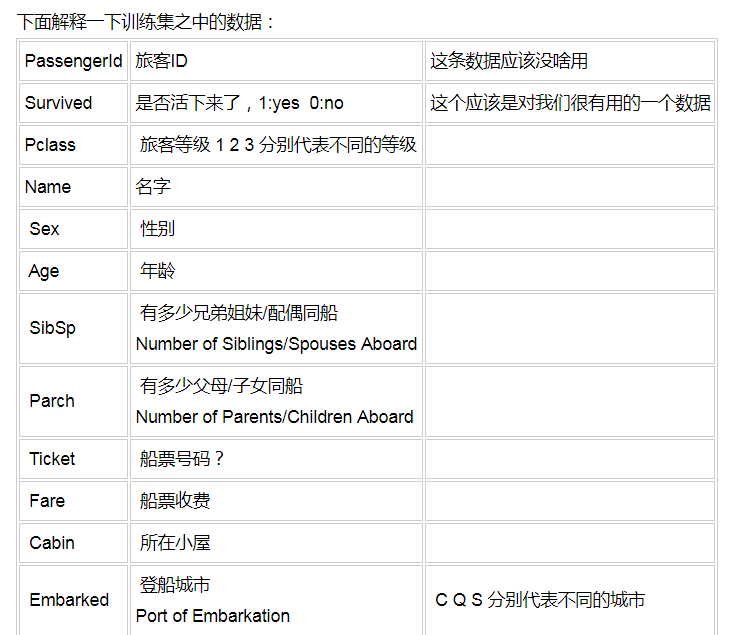
randomForest.py
调参后,预测最高准确性也达到了89%
随机森林的参数
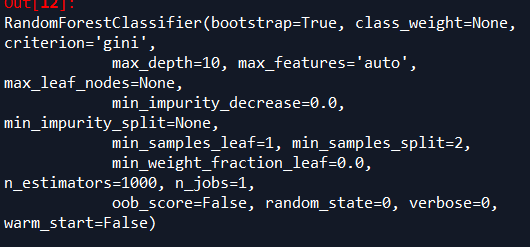
# -*- coding: utf-8 -*-
"""
Created on Sat Mar 31 09:30:24 2018 @author: Administrator
随机森林不需要预处理数据
"""
#导入数据预处理,包括标准化处理或正则处理
from sklearn import preprocessing
from sklearn.preprocessing import Imputer
from sklearn import metrics
import numpy as np
import matplotlib.pyplot as plt
from sklearn.ensemble import RandomForestClassifier
from sklearn.model_selection import train_test_split
import pandas as pd
#中文字体设置
from matplotlib.font_manager import FontProperties
font=FontProperties(fname=r"c:\windows\fonts\simsun.ttc",size=14) #读取变量名文件
varibleFileName="titantic.xlsx"
#读取目标文件
targetFileName="target.xlsx"
#读取excel
data=pd.read_excel(varibleFileName)
data_dummies=pd.get_dummies(data)
print('features after one-hot encoding:\n',list(data_dummies.columns))
features=data_dummies.ix[:,"Pclass":'Embarked_S']
x=features.values #数据预处理
imp = Imputer(missing_values='NaN', strategy='most_frequent', axis=0)
imp.fit(x)
x=imp.transform(x) target=pd.read_excel(targetFileName)
y=target.values
x_train,x_test,y_train,y_test=train_test_split(x,y,random_state=0)
names=features.columns trees=1000
max_depth=10
#n_estimators表示树的个数,测试中100颗树足够
forest=RandomForestClassifier(n_estimators=trees,random_state=0,max_depth=max_depth)
forest.fit(x_train,y_train) print("random forest with %d trees:"%trees)
print("accuracy on the training subset:{:.3f}".format(forest.score(x_train,y_train)))
print("accuracy on the test subset:{:.3f}".format(forest.score(x_test,y_test)))
#print('Feature importances:{}'.format(forest.feature_importances_)) names=features.columns
importance=forest.feature_importances_
zipped = zip(importance,names)
list1=list(zipped) list1.sort(reverse=True)
#print(list1) n_features=data_dummies.shape[1]
plt.barh(range(n_features),forest.feature_importances_,align='center')
plt.yticks(np.arange(n_features),features)
plt.title("random forest with %d trees,%dmax_depth:"%(trees,max_depth))
plt.xlabel('Feature Importance')
plt.ylabel('Feature')
plt.show() '''
random forest with 1000 trees:
accuracy on the training subset:0.983
accuracy on the test subset:0.878 random forest with 1000 trees,max_depth=4:
accuracy on the training subset:0.854
accuracy on the test subset:0.884 random forest with 1000 trees,max_depth=5:
accuracy on the training subset:0.853
accuracy on the test subset:0.887 random forest with 1000 trees,max_depth=9
accuracy on the training subset:0.871
accuracy on the test subset:0.890
'''
去掉覆盖率低的变量后,随机森林准确性反而下降,看了随机森林不需要去计算变量覆盖率
训练数据准确性0.983
测试数据准确性0.878
'''
random forest with 1000 trees:
accuracy on the training subset:0.983
accuracy on the test subset:0.878
'''
重要因子来看,性别第一,占据40%重要性,
年龄重要性18%左右,
票价重要性17%左右
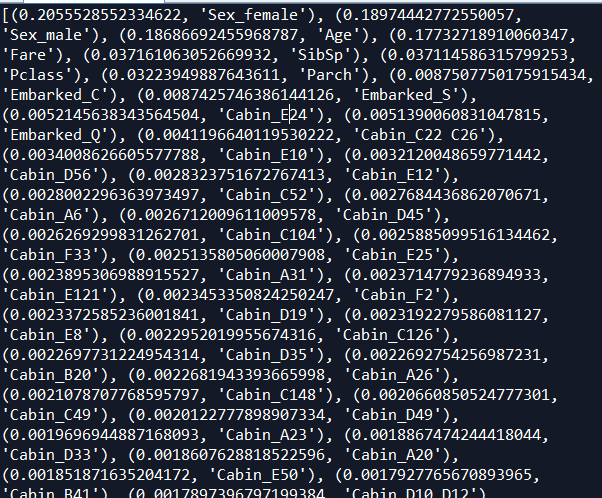
logistic.py
# -*- coding: utf-8 -*-
"""
Created on Sun Apr 29 22:39:35 2018 @author: Administrator
""" # -*- coding: utf-8 -*-
"""
Created on Sat Mar 31 09:30:24 2018 @author: Administrator
随机森林不需要预处理数据
"""
from sklearn.linear_model import LogisticRegression
#导入数据预处理,包括标准化处理或正则处理
from sklearn import preprocessing
from sklearn.preprocessing import Imputer
from sklearn import metrics
import numpy as np
import matplotlib.pyplot as plt
from sklearn.model_selection import train_test_split
import pandas as pd
#中文字体设置
from matplotlib.font_manager import FontProperties
font=FontProperties(fname=r"c:\windows\fonts\simsun.ttc",size=14) #读取变量名文件
varibleFileName="titantic.xlsx"
#读取目标文件
targetFileName="target.xlsx"
#读取excel
data=pd.read_excel(varibleFileName)
data_dummies=pd.get_dummies(data)
print('features after one-hot encoding:\n',list(data_dummies.columns))
features=data_dummies.ix[:,"Pclass":'Embarked_S']
x=features.values #数据预处理
imp = Imputer(missing_values='NaN', strategy='most_frequent', axis=0)
imp.fit(x)
x=imp.transform(x) target=pd.read_excel(targetFileName)
y=target.values
x_train,x_test,y_train,y_test=train_test_split(x,y,random_state=0)
names=features.columns #n_estimators表示树的个数,测试中100颗树足够
logistic=LogisticRegression()
logistic.fit(x_train,y_train) print("logistic:")
print("accuracy on the training subset:{:.3f}".format(logistic.score(x_train,y_train)))
print("accuracy on the test subset:{:.3f}".format(logistic.score(x_test,y_test))) '''
logistic:
accuracy on the training subset:0.850
accuracy on the test subset:0.875
'''
目前效果最好的是去掉低覆盖率的变量后,SVM准确率最高0.89
# -*- coding: utf-8 -*-
"""
Created on Sat Mar 31 09:30:24 2018 @author: Administrator
随机森林不需要预处理数据
"""
from sklearn.svm import SVC
#导入数据预处理,包括标准化处理或正则处理
from sklearn import preprocessing
from sklearn.preprocessing import Imputer
from sklearn import metrics
import numpy as np
import matplotlib.pyplot as plt
from sklearn.model_selection import train_test_split
import pandas as pd
#中文字体设置
from matplotlib.font_manager import FontProperties
font=FontProperties(fname=r"c:\windows\fonts\simsun.ttc",size=14) #读取变量名文件
varibleFileName="titantic.xlsx"
#读取目标文件
targetFileName="target.xlsx"
#读取excel
data=pd.read_excel(varibleFileName)
data_dummies=pd.get_dummies(data)
print('features after one-hot encoding:\n',list(data_dummies.columns))
features=data_dummies.ix[:,"Pclass":'Embarked_S']
x=features.values #数据预处理
imp = Imputer(missing_values='NaN', strategy='most_frequent', axis=0)
imp.fit(x)
x=imp.transform(x) target=pd.read_excel(targetFileName)
y=target.values
x_train,x_test,y_train,y_test=train_test_split(x,y,random_state=0)
names=features.columns svm=SVC()
svm.fit(x_train,y_train)
print("svc:")
print("accuracy on the training subset:{:.3f}".format(svm.score(x_train,y_train)))
print("accuracy on the test subset:{:.3f}".format(svm.score(x_test,y_test))) '''
svc:
accuracy on the training subset:0.900
accuracy on the test subset:0.726
''' #标准化数据
X_train_scaled = preprocessing.scale(x_train)
x_test_scaled = preprocessing.scale(x_test)
svm1=SVC()
svm1.fit(X_train_scaled,y_train)
#改变C参数,调优,kernel表示核函数,用于平面转换,probability表示是否需要计算概率
svm1=SVC()
svm1.fit(X_train_scaled,y_train)
print("accuracy on the scaled training subset:{:.3f}".format(svm1.score(X_train_scaled,y_train)))
print("accuracy on the scaled test subset:{:.3f}".format(svm1.score(x_test_scaled,y_test))) '''
accuracy on the scaled training subset:0.866
accuracy on the scaled test subset:0.881
'''
#改变C参数,调优,kernel表示核函数,用于平面转换,probability表示是否需要计算概率
svm2=SVC(C=10,gamma="auto",kernel='rbf',probability=True)
svm2.fit(X_train_scaled,y_train)
print("after c parameter=10,accuracy on the scaled training subset:{:.3f}".format(svm2.score(X_train_scaled,y_train)))
print("after c parameter=10,accuracy on the scaled test subset:{:.3f}".format(svm2.score(x_test_scaled,y_test))) '''
after c parameter=10,accuracy on the scaled training subset:0.878
after c parameter=10,accuracy on the scaled test subset:0.890
'''
xgboost1.py
效果也相当好
AUC: 0.9464
ACC: 0.8841
Recall: 0.8716
F1-score: 0.8716
Precesion: 0.8716
# -*- coding: utf-8 -*-
"""
Created on Sat Mar 31 09:30:24 2018 @author: Administrator
随机森林不需要预处理数据
"""
import xgboost as xgb
#导入数据预处理,包括标准化处理或正则处理
from sklearn import preprocessing
from sklearn.preprocessing import Imputer
from sklearn import metrics
import numpy as np
import matplotlib.pyplot as plt
from sklearn.model_selection import train_test_split
import pandas as pd
#中文字体设置
from matplotlib.font_manager import FontProperties
font=FontProperties(fname=r"c:\windows\fonts\simsun.ttc",size=14) #读取变量名文件
varibleFileName="titantic.xlsx"
#读取目标文件
targetFileName="target.xlsx"
#读取excel
data=pd.read_excel(varibleFileName)
data_dummies=pd.get_dummies(data)
print('features after one-hot encoding:\n',list(data_dummies.columns))
features=data_dummies.ix[:,"Pclass":'Embarked_S']
x=features.values #数据预处理
imp = Imputer(missing_values='NaN', strategy='most_frequent', axis=0)
imp.fit(x)
x=imp.transform(x) target=pd.read_excel(targetFileName)
y=target.values
x_train,x_test,y_train,y_test=train_test_split(x,y,random_state=0)
names=features.columns dtrain=xgb.DMatrix(x_train,label=y_train)
dtest=xgb.DMatrix(x_test) params={'booster':'gbtree',
#'objective': 'reg:linear',
'objective': 'binary:logistic',
'eval_metric': 'auc',
'max_depth':4,
'lambda':10,
'subsample':0.75,
'colsample_bytree':0.75,
'min_child_weight':2,
'eta': 0.025,
'seed':0,
'nthread':8,
'silent':1} watchlist = [(dtrain,'train')] bst=xgb.train(params,dtrain,num_boost_round=100,evals=watchlist) ypred=bst.predict(dtest) # 设置阈值, 输出一些评价指标
y_pred = (ypred >= 0.5)*1 #模型校验
print ('AUC: %.4f' % metrics.roc_auc_score(y_test,ypred))
print ('ACC: %.4f' % metrics.accuracy_score(y_test,y_pred))
print ('Recall: %.4f' % metrics.recall_score(y_test,y_pred))
print ('F1-score: %.4f' %metrics.f1_score(y_test,y_pred))
print ('Precesion: %.4f' %metrics.precision_score(y_test,y_pred))
metrics.confusion_matrix(y_test,y_pred) print("xgboost:")
print('Feature importances:{}'.format(bst.get_fscore())) '''
AUC: 0.9464
ACC: 0.8841
Recall: 0.8716
F1-score: 0.8716
Precesion: 0.8716
xgboost:
Feature importances:{'f5': 69, 'f1': 178, 'f2': 68, 'f4': 245, 'f6': 25, 'f0': 88, 'f3': 25, 'f194': 4, 'f193': 21, 'f195': 9}
'''
决策树
decisionTree.py
# -*- coding: utf-8 -*-
"""
Created on Mon Apr 30 19:04:10 2018 @author: Administrator
"""
from sklearn.tree import export_graphviz
from sklearn.model_selection import train_test_split
from sklearn.preprocessing import Imputer
import pandas as pd
import numpy as np
from sklearn.tree import DecisionTreeClassifier
import matplotlib.pyplot as plt #读取变量名文件
varibleFileName="titantic.xlsx"
#读取目标文件
targetFileName="target.xlsx"
#读取excel
data=pd.read_excel(varibleFileName)
data_dummies=pd.get_dummies(data)
print('features after one-hot encoding:\n',list(data_dummies.columns))
features=data_dummies.ix[:,"Pclass":'Embarked_S']
x=features.values #数据预处理
imp = Imputer(missing_values='NaN', strategy='most_frequent', axis=0)
imp.fit(x)
x=imp.transform(x) target=pd.read_excel(targetFileName)
y=target.values
X_train,x_test,y_train,y_test=train_test_split(x,y,random_state=0)
#变量名
names=features.columns #调参
list_average_accuracy=[]
depth=range(1,30)
for i in depth:
#max_depth=4限制决策树深度可以降低算法复杂度,获取更精确值
tree= DecisionTreeClassifier(max_depth=i,random_state=0)
tree.fit(X_train,y_train)
accuracy_training=tree.score(X_train,y_train)
accuracy_test=tree.score(x_test,y_test)
average_accuracy=(accuracy_training+accuracy_test)/2.0
#print("average_accuracy:",average_accuracy)
list_average_accuracy.append(average_accuracy) max_value=max(list_average_accuracy)
#索引是0开头,结果要加1
best_depth=list_average_accuracy.index(max_value)+1
print("best_depth:",best_depth) best_tree= DecisionTreeClassifier(max_depth=best_depth,random_state=0)
best_tree.fit(X_train,y_train)
accuracy_training=best_tree.score(X_train,y_train)
accuracy_test=best_tree.score(x_test,y_test) print("decision tree:")
print("accuracy on the training subset:{:.3f}".format(best_tree.score(X_train,y_train)))
print("accuracy on the test subset:{:.3f}".format(best_tree.score(x_test,y_test))) '''
best_depth: 19
decision tree:
accuracy on the training subset:0.976
accuracy on the test subset:0.860
''' #绘图,显示因子重要性
n_features=x.shape[1]
plt.barh(range(n_features),best_tree.feature_importances_,align='center')
plt.yticks(np.arange(n_features),features)
plt.title("Decision Tree:")
plt.xlabel('Feature Importance')
plt.ylabel('Feature')
plt.show() #生成一个dot文件,以后用cmd形式生成图片
export_graphviz(best_tree,out_file="Titanic.dot",class_names=['death','live'],feature_names=names,impurity=False,filled=True)
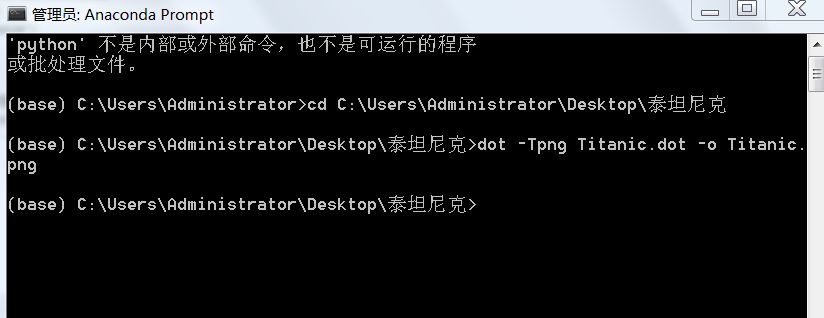
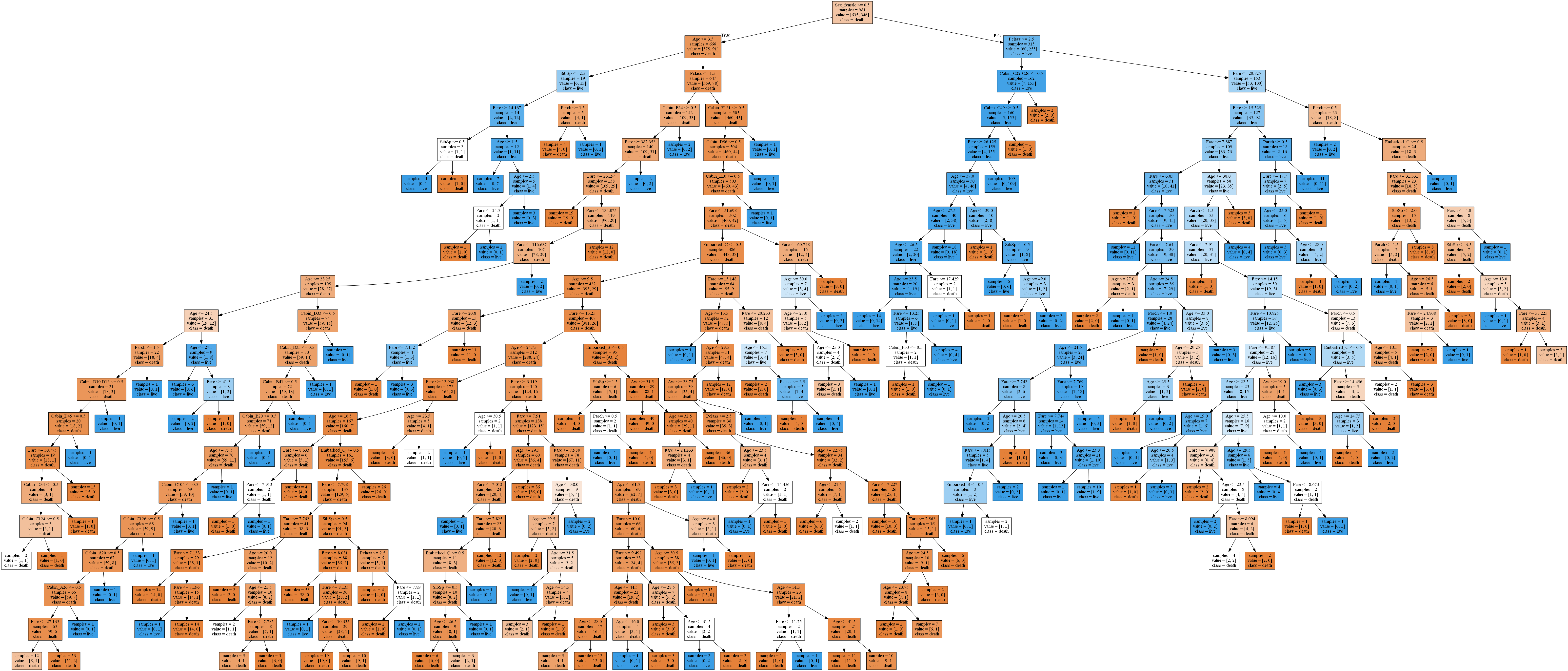
python风控评分卡建模和风控常识
sklearn机器学习-泰坦尼克号的更多相关文章
- Python 3 利用 Dlib 19.7 和 sklearn机器学习模型 实现人脸微笑检测
0.引言 利用机器学习的方法训练微笑检测模型,给一张人脸照片,判断是否微笑: 使用的数据集中69张没笑脸,65张有笑脸,训练结果识别精度在95%附近: 效果: 图1 示例效果 工程利用pytho ...
- 使用sklearn机器学习库实现线性回归
import numpy as np # 导入科学技术框架import matplotlib.pyplot as plt # 导入画图工具from sklearn.linear_model imp ...
- Python线性回归算法【解析解,sklearn机器学习库】
一.概述 参考博客:https://www.cnblogs.com/yszd/p/8529704.html 二.代码实现[解析解] import numpy as np import matplotl ...
- 用python+sklearn(机器学习)实现天气预报数据 模型和使用
用python+sklearn机器学习实现天气预报 模型和使用 项目地址 系列教程 0.前言 1.建立模型 a.准备 引入所需要的头文件 选择模型 选择评估方法 获取数据集 b.建立模型 c.获取模型 ...
- 用python+sklearn(机器学习)实现天气预报数据 数据
用python+sklearn机器学习实现天气预报 数据 项目地址 系列教程 勘误表 0.前言 1.爬虫 a.确认要被爬取的网页网址 b.爬虫部分 c.网页内容匹配取出部分 d.写入csv文件格式化 ...
- 用python+sklearn(机器学习)实现天气预报 准备
用python+sklearn机器学习实现天气预报 准备 项目地址 系列教程 0.流程介绍 1. 环境搭建 a.python b.涉及到的机器学习相关库 sklearn panda seaborn j ...
- 5分钟教你玩转 sklearn 机器学习(上)
假期结束,你的状态有没有回归?那么,放空脑袋后,先来学习学习,欢迎大家继续关注腾讯云技术社区. 作者:赵成龙 这是一篇很难写的文章,因为我希望这篇文章能对大家有所帮助.我不会给大家介绍机器学习,数据挖 ...
- 编程作业1.1——sklearn机器学习算法系列之LinearRegression线性回归
知识点 scikit-learn 对于线性回归提供了比较多的类库,这些类库都可以用来做线性回归分析. 我们也可以使用scikit-learn的线性回归函数,而不是从头开始实现这些算法. 我们将scik ...
- sklearn机器学习-特征提取1
scikit-learn机器学习的特征提取部分较多nlp内容,故学到一半学不下去,看完nltk再来补上 scikit-learn机器学习的特征提取这一章感觉讲的不是特别好,所以会结合着来看 首先是Di ...
随机推荐
- python第三方库的四种安装方法
1,直接pip install安装 2,在python-->default setting-->project interprer-->add 3,在这个链接里找到需要的包,下载 h ...
- IDEA下载依赖时提示 resolving dependencies of xxx, yyy
IDEA下载依赖时提示 resolving dependencies of xxx, yyy ,卡住不动 使用Maven命令可以更清楚地分析问题,在IDEA命令行窗口执行mvn compile命令,提 ...
- BZOJ2176Strange string——最小表示法
题目描述 给定一个字符串S = {S1, S2, S3 … Sn}, 如果在串SS中, 子串T(|T| = n)为所有长度为n的SS的字串中最小的(字符串的比较), 则称T为”奇怪的字串”. 你的任务 ...
- 安卓Android基础第五天
使用HttpUrlConnection方式提交到服务器2 Get方式:组拼url地址把数据组拼到url上,有大小限制1kb(浏览器)或4kb(http协议) Post方式:post方式提交安全,没有大 ...
- 【洛谷U20626】gemo 容斥 FWT 高斯消元
题目大意 给你一个无向图,有\(m\)个询问,每次给你一个点\(x\)和一个点集\(S\),问你从\(x\)开始走,每次从一个点随机的走到与这个点相邻的点,问你访问\(S\)中每个点至少一次的期望步数 ...
- Failed to load package MonoAndroidDesignerPackage
from : https://developercommunity.visualstudio.com/content/problem/160124/failed-to-load-package-mon ...
- SQL循环语句 详解
SQL循环语句 declare @i int set @i=1 while @i<30 begin insert into test (userid) values(@i) set @i=@i+ ...
- word 2013 题注、图注、插入图片自动修改大小、批量更新题注编号
1 .题注 图片下面的文字说明,如 图 1.1.1 2.图注 图的标题格式,可以右键修改段落为居中,选中图片,点下此格式快捷居中等其他格式 3. 题注插入 效果 如下 4.题注自动居中对齐 先点击图 ...
- MT【270】含参绝对值函数最大之二
已知$f(x)=2ax\cos^2x+(a-1)\cos x-1,a>0$,记$|f(x)|$的最大值为$A$,1)求A.2)证明:$|-2a\sin 2x+(1-a)\sin x|\le 2A ...
- Hdoj 1785.You Are All Excellent 题解
Problem Description 本次集训队共有30多人参加,毫无疑问,你们都是很优秀的,但是由于参赛名额有限,只能选拔部分队员参加省赛.从学校的角度,总是希望选拔出最优秀的18人组成6支队伍来 ...

